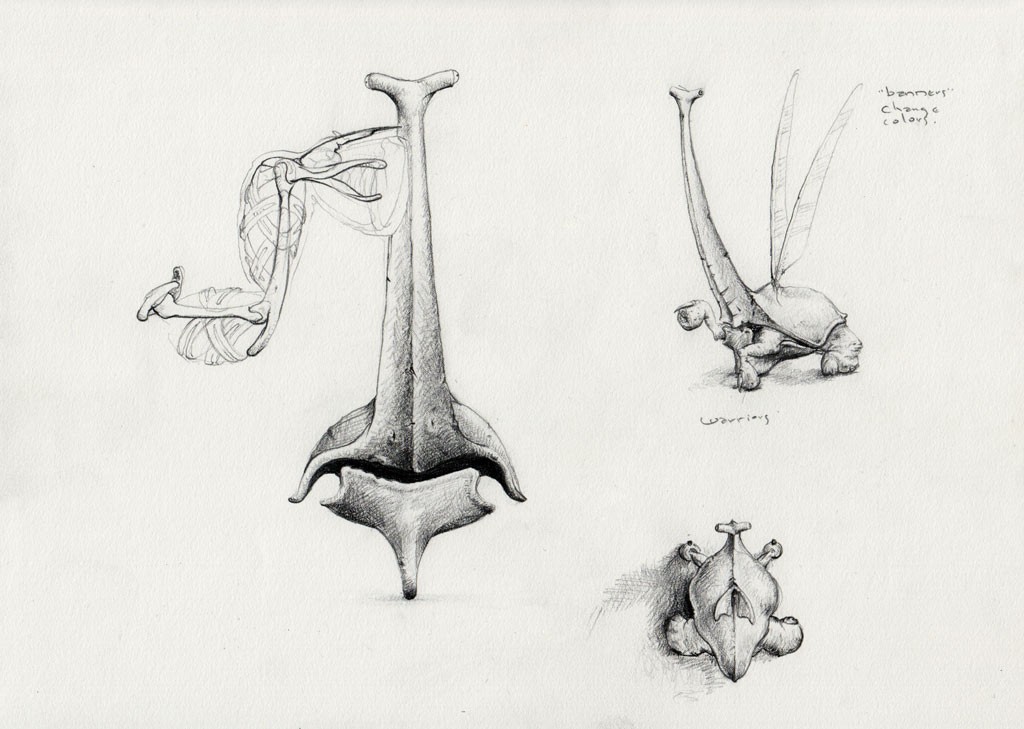
The little guy’s complete!
Continue reading “Ashlesan Warrior of the Southern Heart, complete”

The little guy’s complete!
Continue reading “Ashlesan Warrior of the Southern Heart, complete”

Painting is nearly done! You can see a spot I missed completely on the right knee, and there are a couple of spots that still need work, but the body’s just about done. Next come the banners, which will brighten the monochrome substantially. More pics under the cut!
I’ve been working on this guy quite a bit. Materials have been about $25. No special tools, but I made some sculpting tools out of music wire and dowels. More pics below the cut!

In the geyland called the Southern Heart lives a species called “warriors” by the explorers who first discovered them. They’re herd animals, living among twenty or thirty of their kind. They’re about 1m tall, to the top of their banners and eyes and about half as long. Their feet each contain a circular mouth on the bottom, covered in raspy skin that they use to scrape minerals and microfauna off the ground. On the front of those feet single spikes. Their paired eyes are at the top of a tall tower at the front of their smooth, tortoise-like shells. Sprouting from their backs through a small hole in their carapaces are two tall feather-like banners in shifting, bright colors and patterns. Their hind legs are thick and strong, but the front ones are lithe and move in quick, snappy motions.
Warrior herds graze within eyesight of one another, no more than 12m away from each other. The twin banners on their backs are for herd communication. Each herd has a unique pattern that varies with context. The better the food, the broader the stripes, for instance, with herd members moving closer to individuals whose stripes indicate a better food source. They also sound the alarm, signaling predators and seeing other herds. The high eye towers allow them to see over other herd members while they graze, and quickly see changes in the environment and alert others to that change.
The muscles of the warriors, like those of most creatures of the Southern Heart, are hydraulic and work in compression, rather than the tension as most terran muscles do. Like many arthropods on Earth, they have very limited tensor muscles, gaining their real strength and speed from their hydraulic system.
When an individual warrior sees another herd, its banners suddenly change color into vibrant stripes that are clearly distinguishable from those of the other herd. They then charge into battle at a glacial pace, their thick hind legs pushing them forward and their front limbs working together to lift the keel of their shells off the ground. As they approach, the banners of the individuals change patterns subtly to indicate tactical openings they see. They coördinate themselves like this, inching themselves into position until they stand close enough to other individuals that they can strike with their barbed forelimbs. But this battle is not for territory or resources. The barb on the creatures’ forelimbs are injectors of spermlike structures, carrying the individual’s genes into the circulatory system of the struck individual. It also contains a hormone that causes the struck individual to stop fighting and signaling, recovering completely only well after the fight has ended.
The spermoforms are carried by the recipient’s circulatory system to an ovary, where they gestate for several days, eventually to be born in a 10cm sack, its eye tower collapsed along its back. The mother helps tear open the egg sac and the newborn climbs onto the mother’s back, where the eye tower erects over a few minutes. While on its mother’s back, it begins mimicking the coloration of the banners in its own herd. The shell hardens over a few days and the newborn begins grazing alongside other individuals. Over the course of a season, it will grow to full size, now part of its mother’s army.
If you have any questions about the warriors, the geyland of the Southern Heart, or anything else about Ashlesa, please put them in the comments and I’ll be sure to pass them on to the proper Ashlesologists.
Want to know more about Ashlesa? There are several articles on this blog. As exploration continues, more will be posted.